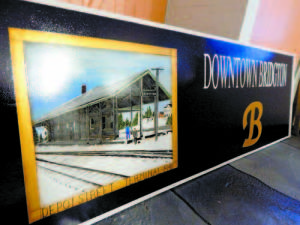Hand painted signs worth the wait, artist believes

The Depot Street Train Station was chosen for the main ground sign directing visitors to the downtown because “It’s part of the history of this town,†said signmaker Nelle Ely. She said she was given the style of the letter “B,†denoting Bridgton, by the town for use on all of the signs.
By Gail Geraghty
Staff Writer
If the Bridgton Board of Selectmen is willing, artist Nelle Ely intends to fulfill her contract and finish work on the wayfaring signs she was charged with creating.
“I intend to fulfill my obligation, and I hope they will allow me to do so,†Ely said Monday.
The signs were due Nov. 30, but several factors — not all of which were in her control — have delayed the project. She regrets the delay, but at the same time doesn’t want to assign blame. Ely simply wishes to explain her side of the story, in response to criticisms leveled at her sign-making abilities at last week’s selectmen meeting.
“I elected to stay away (from the meeting) and not walk into a situation that was volatile,†said Ely, referring to public statements made by a professional sign painter that her signs were unprofessional in both materials and design. “It hurt, some of the things that were said hurt, but I have great confidence in my work and what I do.â€
As someone who has painted several murals and signs in town, Ely, owner of Twin Town Studios, was an enthusiastic advocate of the need for uniform municipal signage as a member of the Community Development Committee. She was just as enthusiastic about the value of hand-painted signs over those that are machine-made — and she pointed out that a majority of selectmen agreed with her.
“The town asked me to design (the signs). They did not ask me to find an engineer to design them.†Drawing up design specs would have cost upwards of $10,000, “and I didn’t charge them anything,†she said. “They asked me to design hand-painted signs. They did not want a machine-made sign.â€
The 3-2 deciding vote in April was close, though, with board members Bernie King and Paul Hoyt, preferring the much less expensive machine-made signs bid by Welch Signage.
Ely chose a blue background with white trim and lettering for all the signs, using New Times Roman, a popular font style for traffic and directional signs. She used two coats of a polymer primer on MDO board and acrylic-based Golden Paints, which she said holds up much better than the oil-based paints used by her bidding competitor, Welch Signage, and other professional sign makers.
“I will not use any paints that have pollutants in them,†said Ely. A gel “isolation†coat goes over the background and lettering to protect the surface from any damage. The completed sign is then sprayed with a clear car coat by Dale McDaniel, which she said ensures that the signs “should outlast any of us.â€
Along with her commitment to being an active member of the town she’s called home since 2001, Ely said, “If I have a goal in life, it’s to keep hand-painted signs and hand-painted murals alive. It’s part of Americana and it’s part of our history.†Go to a museum, she said, and you’ll see many of the best old signs hung as works of art. The trouble is, she said, “It’s a dying art — and as long as I have requests to paint signs and murals, I’m going to continue to do so, because I love art.â€
Ely has created four large ground signs for the downtown and the town beaches that include her original artwork. As a history buff, Ely depicted the old Depot Street train station on the downtown sign, and it was a decision supported by town staff that inspected the signs. It’s also part of the reason why her signs were more expensive — each painting required around 80 hours of work to create. Had the town gone with a machine made option, the artwork would have been pre-painted on paper and glued on the sign, she said.
Ely used three-inch-tall lettering on each of the directional signs, and the reason several of the signs were rejected was that selectmen wanted more spacing between the words, she said. “Stevens Brook Trail†thus needed to be abbreviated as “Stevens Brook Trl,†and “Downtown District†became “Downtown Dist.â€
“Normally when you’re doing a sign you do not break up the words or abbreviate,†said Ely.
The next few weeks will be busy ones for Ely in her studio to finish the project, but she points out that despite the controversy, her motivation remains unchanged.
“I have been so much a part of this town since 2001, as president of the Rotary and the Rufus Porter Museum, serving on the CDC and the Bridgton Community Center Board of Directors,†Ely said. “I could stay home. I’m not going to starve if I don’t do this. But I’ve gotten a lot of phone calls from people saying they love my work, and I do this out of love — and my desire to keep hand-painted murals and signs alive.â€

